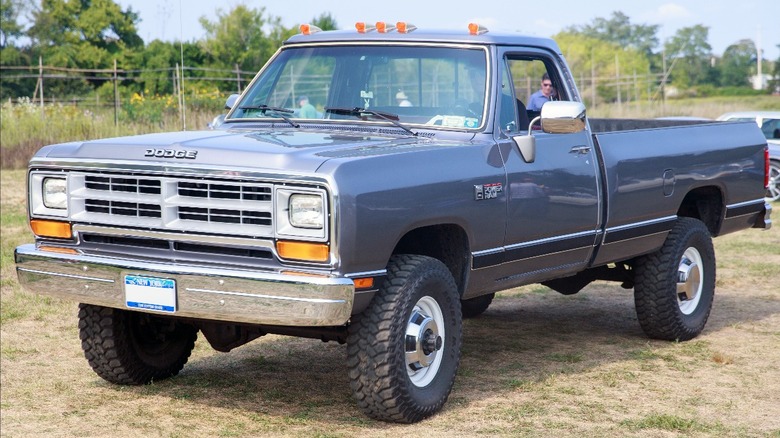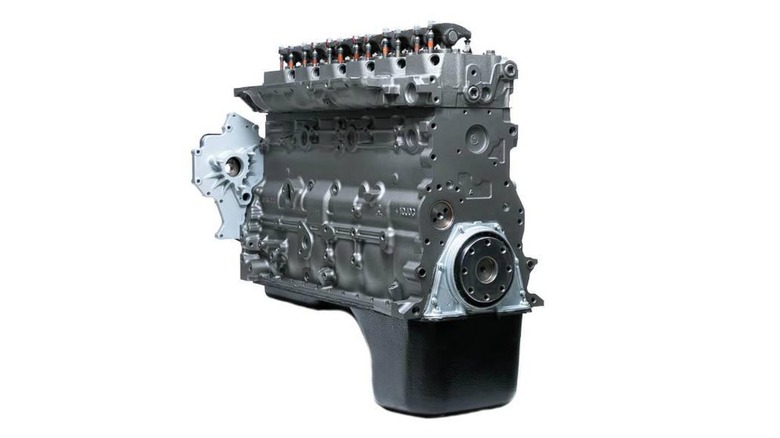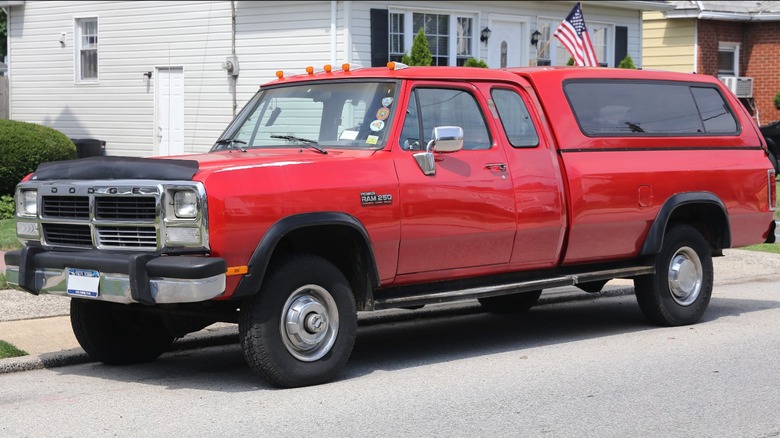What Years Are First-Gen Cummins Engines And How Much Does One Cost Today?
The late 1980s were a very important time for consumer diesel pickup trucks, as the torque wars between the Big Three American auto manufacturers began ramping up. In the late 1970s and early 1980s, Ford, General Motors, and Chrysler/Dodge all offered diesel trucks of varying capabilities. Ford's seventh generation F-Series trucks were a popular option, equipped with a 6.9L Harvester-built IDI diesel that made 161 horsepower and 307 lb-ft of torque starting in 1983. In the GM camp was the Chevy C/K, which received a new clean-sheet 6.2-liter GM/Detroit Diesel V8 capable of 130 horsepower and 240 lb-ft of torque in 1982. Last and most certainly least was Dodge's D-Series, a family of trucks that was still built on a chassis from the early 1970s. In 1978, Dodge began offering a D-Series diesel which featured a Mitsubishi-sourced six-cylinder diesel that could muster only 105 horsepower and 169 lb-ft of torque. Sales of the diesel D-Series were abysmal, and it was fair to say that Dodge was firmly at the back of the pack.
That all changed in a big way with the introduction of the first-gen 5.9L Cummins in 1989. By that point, Dodge had renamed the D-Series to "Ram" in an attempt to revitalize the declining truck line, and the 5.9 Cummins was the key that made it possible. With an array of then-cutting-edge diesel technology, including direct injection and turbocharging, the 5.9L Cummins is considered one of the best diesel engines ever made. The first-gen Cummins can sell for anywhere between $17,000 and $35,000 today, thanks to their stellar reputation and historic importance.
[Featured image by Mr.choppers via Wikimedia Commons | Cropped and scaled | CC BY 3.0]
The first-gen 5.9L Cummins was way ahead of the curve
When the 5.9-liter Cummins, also known as the B-Series, arrived on the scene in 1989, it immediately became the benchmark for consumer diesel engines. The 5.9 Cummins was meant for industrial and agricultural equipment, such as tractors, mobile cranes, and wheel-loaders. This meant it was notoriously durable and over-engineered for a truck application. It also featured some revolutionary design choices, especially its direct injection system and use of a fixed-geometry turbocharger.
One of the biggest selling points of the 5.9-liter Cummins was its massive torque production. While the engine's long-stroke design was a big reason for its 400 lb-ft output, its use of a fixed geometry Holset H1C turbocharger also played an important role in making the 5.9 Cummins a class leader in both power and torque output. Prior to the 5.9 Cummins, turbochargers were almost exclusively used on industrial applications and 18-wheelers, marking a huge shift in the consumer truck market toward turbodiesels. In an effort to keep up with Dodge, GM and Ford developed their Duramax and Power Stroke turbo diesel engine lines, and the battle between the three continues to this day.
Prior to the 5.9 Cummins, consumer diesel truck engines used indirect fuel injection – where fuel and air are mixed in a swirl chamber before igniting and traveling to the cylinder. The 5.9 Cummins was the first consumer diesel engine to feature direct injection, where fuel was injected directly into the combustion chamber, dramatically improving its power output and fuel efficiency. The initial 12-valve variant of the 5.9 Cummins used a Bosch VE mechanical injection pump that was well-liked for its incredible reliability, even though it did limit power production substantially.
First-Gen Cummins Rams are still valuable today
The first-gen Cummins Ram was sold from 1989 until 1993 and was an immediate hit in the diesel truck market, selling 16,750 units the first year and surpassing Dodge's sales projections. It was built on the same chassis as the old D-Series Dodge trucks that had already been around for over a decade in 1989. Despite being a recycled chassis, the platform was still capable of handling the excessive torque generated by its 5.9 Cummins party piece, so it wasn't fully refreshed until 1994.
As with the rest of the chassis, the first-gen Cummins also featured many familiar D-Series components, including rear drum brakes, leaf spring suspension, and Dana axles. There were multiple different transmission options available, including a three-speed TorqueFlite A-727 and a Getrag G360 five-speed manual initially. From 1991 onward, the three-speed TorqueFlite was replaced with a four-speed A518. The 5.9 Cummins was available in both ¾ and 1-ton trucks, which came in both rear-wheel and all-wheel drive.
In mid-1991, the first-gen Cummins got a notable revision to its 5.9-liter power plant. In the years prior, the 5.9 Cummins did not feature an intercooler for its turbocharger, which, while still effective, limited the engine's performance. Halfway through the 1991 model year, Dodge added an intercooler, which decreased intake air temperatures, improved fuel economy, and increased power output. In combination with the four-speed overdrive transmissions that were added in 1991, the intercooled engine in late model first-gen Cummins Rams makes 1991-1993 models the most valuable in the current market. According to Hagerty, prices for first-gen Cummins have been climbing steadily since 2015. In fact, they are fetching significantly more than their gas-burning counterparts.
[Featured image by Mr.choppers via Wikimedia Commons | Cropped and scaled | CC BY 3.0]


